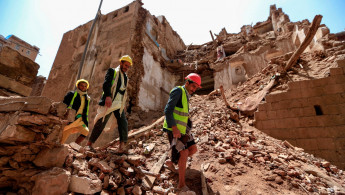After years of conflict, UNESCO heritage sites across the country, including in Shibam further east, renowned for its high-rise mud-brick skyscrapers, as well as the Old Sanaa City and the 8th-century Marib Dam, now face imminent risk of damage or collapse due to natural causes.
"The collapse of historic edifices in Sanaa, Zabid, and Shibam requires an urgent intervention to prevent further destruction. However, most of Yemen's historic sites will require complete restorations that can only be executed during the cessation of hostilities," Sama'a Al-Hamdani, founder and director of The Yemen Cultural Institute for Heritage & the Arts [YCIHA] told The New Arab.
In the capital Sanaa, 106 buildings, including five in the Old City, have been destroyed so far and 156 damaged, a source at the Houthi health ministry told AFP.
At least 19 children were among 30 people killed by floods in the mainly government-held province of Marib east of the capital, a government official said.
In the province's displaced persons camps, 1,340 families saw their tents and belongings swept away, the agency in charge of them said. Meanwhile in Lahj province in the government-held south, seven people drowned when their vehicle was swept downstream, a government official told AFP.
 |
After years of conflict, UNESCO heritage sites across the country now face imminent risk of damage or collapse |  |
Another four people were killed on the road connecting the southern provinces of Hadramawt and Shabwa, the official added.
Responding to the crisis on Wednesday, UNESCO said it launched an emergency initiative alongside the local Yemeni Social Fund for Development organisation to intervene in 40 new buildings in the Old City, under the European Union's Delegation to Yemen's "generous" support to employ hundreds of youths in the capital, a statement said.
Read more: Yemen's historic Marib dam floods for first time in 34 years
The UN body vowed to scale up its interventions in Sanaa in the coming few days to target more buildings by diverting available funds from other activities and focusing on emergency response.
Twitter Post
|
In Shibam and Zabid, where less damage was reported, UNESCO said it began work to provide emergency restorations and repairs in houses, city walls and public areas.
The destruction has dealt a new blow to a country already in the grip of what the United Nations describes as the world's worst humanitarian crisis after years of war between a Saudi-backed government and the Iran-allied Houthi rebels.
But Al-Hamdani said current efforts would only provide temporary relief in a country impatiently waiting for a real breakthrough.
"Like the Yemeni population, Yemen's heritage has sustained armed conflict and natural disasters; however, the status quo is not sustainable and will result in devastation," Al-Hamdani said.
"Yemen's culture is hugely under threat, and any current 'rescue' efforts will yield temporary fixes in the absence of real peace.
"Many protection efforts are managed virtually and are underfunded. Yemenis can no longer rely on foreign aid or donors to rescue their cultural antiquities. As private businessmen funds continue to support many restoration efforts, it is time to enable young grassroots Yemenis to preserve their own culture," she added.
The work of those involved in protecting the nation's heritage was being hampered by dysfunction and a lack of political will across the country, and the 2015 intervention of a Saudi-led coalition in support of the government against the Houthis escalated the conflict on multiple levels.
Coalition warplanes have long been accused of targeting civilians as well as historic sites, including the Old City of Sanaa, which has been inhabited for more than 2,500 years.
 |
Yemen's historic architecture can only be saved through a much-needed ceasefire, experts have warned |  |
More than 100,000 people have been killed since the conflict intensified with the Saudi-led coalition military intervention in March 2015, while millions have been displaced internally and externally.
Some 24 million Yemenis - four-fifths of the population - are dependent on some form of humanitarian aid.
The devastating floods in the Arab world's poorest country have also exacerbated a cholera outbreak, with 127,900 suspected cases across eight provinces since January, the World Health Organization said earlier this month.
The ICRC warned the floods have also accelerated the spread of dengue fever and malaria, as mosquitoes carrying the diseases breed in puddles. Yemen has also hit with Covid-19, which has infected thousands across a country that has sine 2015 since its health facilities and infrastructure all-but decimated by conflict.
Efforts to end the devastating war have so far yielded little to no results despite numerous UN-sponsored peace talks and regional mediations.
Yemen In Focus is a regular feature from The New Arab.
Sana Uqba is a journalist at The New Arab.
Follow her on Twitter: @Sanasiino



